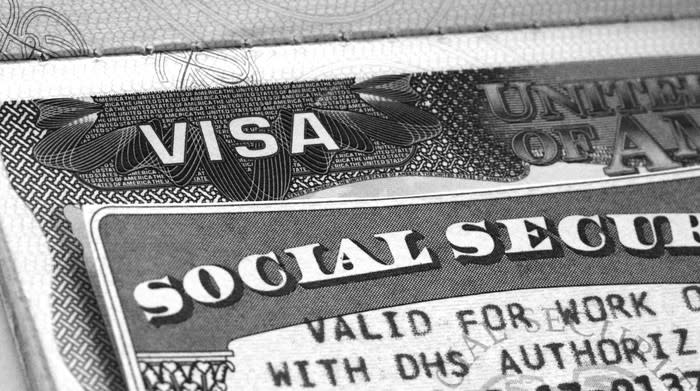Social Security and Immigration: Setting the Record Straight
Ready or not, folks, we're less than 15 months away from the 2020 elections. And while there are a number of hot-button topics for candidates from both parties to discuss, the future of Social Security, and how immigration impacts our nation's most successful social program, are two topics that rightly deserve their time in the spotlight.
Are you prepared for a 23% cut to retired worker benefits?
As many of you are probably aware, Social Security is facing its toughest challenge in more than eight decades because of a number of ongoing demographic changes. The newest Social Security Board of Trustees report found that the program will begin spending more than it brings in via revenue beginning in 2020. To provide some context, this'll be the first time the program has had a net cash outflow since 1982.

Image source: Getty Images.
With each passing year, this net cash outflow from Social Security is expected to grow larger, dwindling the program's nearly $2.89 trillion in asset reserves in the process. By the time 2035 rolls around, the trustees have forecast that Social Security's excess cash built up since inception will be completely gone.
Now, Social Security not having a dime in asset reserves doesn't mean the program is insolvent or bankrupt. Social Security's two recurring sources of revenue -- the 12.4% payroll tax on earned income, and the taxation of benefits -- ensure that bankruptcy is impossible, since there will always be money flowing into the program for disbursement to eligible beneficiaries. But it does demonstrate that the current payout schedule isn't sustainable over the long-term, which is defined as the next 75 years.
Should Social Security's asset reserves be whittled away, the trustees have projected the need for an across-the-board cut in benefits for retired workers of up to 23%. That's a problem considering that more than 3 out of 5 retirees lean on Social Security for at least half of their monthly income.
Setting the record straight on immigration
The questions we should be asking are: "What do we do about Social Security?" or "How do we fix it?"
Unfortunately, partial blame for the mess Social Security is in sometimes turns to immigrants, both legal and illegal, who have come to the United States. Today, we'll set the record straight on how immigration (legal and illegal) impacts the Social Security program.

Image source: Getty Images.
Peruse any Social Security blog or publication, and chances are very good that you'll come across one or multiple comments describing how immigration, and more specifically undocumented workers, have contributed to Social Security's financial malaise. But if we go straight to the source -- the Social Security Board of Trustees -- we're told a different story about immigrants.
According to data and projections in the 2019 trustees' report, legal immigration isn't just a positive for the Social Security program -- it's vital to its existence. Immigrants that legally immigrate to the United States are often young, which means they're likely to jump into the U.S. workforce for many decades to come. Being given the opportunity to seek citizenship, they'll pay into Social Security via the payroll tax like every other American citizen, and might even earn themselves a retired worker benefit when they retire many decades down the line.
Based on the trustees' intermediate-cost model, which assumes an annual average net immigration rate of 1.265 million people over the next 75 years, the actuarial deficit stands at 2.78%. The actuarial deficit is a numerical expression of how much the payroll tax would need to increase today to completely offset the $13.9 trillion forecast cash shortfall in Social Security over the long-term, based on the current payout schedule and inclusive of cost-of-living adjustments. But if average annual net immigration were to rise to 1.601 million from 1.265 million over this 75-year period, the forecast actuarial deficit declines by 23 basis points to 2.55%.
In other words, if the U.S. opens its doors to more legal-pathway immigrants, Social Security becomes financially stronger.
Here's what you need to know about illegal immigrants and their impact on Social Security
Of course, the point of contention is often with those immigrants in the U.S. who are undocumented and don't have a path to citizenship. What you might be surprised to learn is that so-called illegal immigrants don't have a negative impact on the traditional Social Security program.

Image source: Getty Images.
To begin with, undocumented workers will be unable to get a valid Social Security number (SSN). Without a valid SSN, undocumented immigrants won't be able to accrue credits toward any traditional Social Security benefits and, therefore, won't be able to receive any benefits from the program.
There are instances where undocumented workers have used a false SSN, or a friend's SSN, to gain employment. As a result of such instances, Social Security collects an estimated $13 billion a year in payroll tax revenue from undocumented workers, or a little more than 1% of its total revenue. Rephrased another way, these undocumented workers have no chance of collecting a traditional retired worker benefit, but are collectively contributing $13 billion a year to the Social Security program.
Another aspect of illegal immigration you should be aware of is the difference between a traditional Social Security benefit and a Supplemental Security Income (SSI) payout. Although the Social Security Administration oversees both programs, the two should not be conflated. SSI is available to asylum seekers, with SSI being funded entirely through the federal government's General Fund. Meanwhile, Social Security is funded separately from the General Fund, and traditional benefits are not made available to undocumented workers, period. An undocumented immigrant receiving an SSI payout has zero impact on the financial stability of the Social Security program.
Now, the record has been set straight.
The Motley Fool has a disclosure policy.
This article was originally published on Fool.com

 Yahoo Finance
Yahoo Finance 